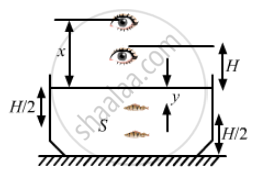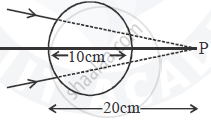Advertisements
Advertisements
Question
Consider the situation in figure. The bottom of the pot is a reflecting plane mirror, S is a small fish and T is a human eye. Refractive index of water is μ. (a) At what distance(s) from itself will the fish see the image(s) of the eye? (b) At what distance(s) from itself will the eye see the image(s) of the fish.

Solution
Given,
Refractive index of water = μ.
Height of the pot = H
Let us take x as the distance of the image of the eye formed above the surface of the water as seen by the fish.
We can infer from from the diagram,
The distance of the direct image
Similarly, image through mirror =
b) We know that:
Where, y is the distance of the image of the fish below the surface as seen by the eye.
Direct image =
Again another image of fish will be formed H/2 below the mirror.
Real depth for that image of fish becomes H + H/2 = 3H/2
So, apparent depth from the surface of water = 3H/2μ
So, distance of the image from the eye
APPEARS IN
RELATED QUESTIONS
A small pin fixed on a table top is viewed from above from a distance of 50 cm. By what distance would the pin appear to be raised if it is viewed from the same point through a 15 cm thick glass slab held parallel to the table? Refractive index of glass = 1.5. Does the answer depend on the location of the slab?
- Figure shows a cross-section of a ‘light pipe’ made of a glass fibre of refractive index 1.68. The outer covering of the pipe is made of a material of refractive index 1.44. What is the range of the angles of the incident rays with the axis of the pipe for which total reflections inside the pipe take place, as shown in the figure?

- What is the answer if there is no outer covering of the pipe?
A diver under water, looks obliquely at a fisherman standing on the bank of a lake. Would the fisherman look taller or shorter to the diver than what he actually is?
The refractive index of diamond is much greater than that of ordinary glass. Is this fact of some use to a diamond cutter?
A fish which is at a depth of l2 em .in water
a) 3 cm
b) 9 cm
c) 12 cm
d) 16 cm
A laser light is focussed by a converging lens. Will there be a significant chromatic aberration?
A point object is placed at a distance of 30 cm from a convex mirror of focal length 30 cm. The image will form at
Figure shows a transparent hemisphere of radius 3.0 cm made of a material of refractive index 2.0. (a) A narrow beam of parallel rays is incident on the hemisphere as shown in the figure. Are the rays totally reflected at the plane surface? (b) Find the image formed by the refraction at the first surface. (c) Find the image formed by the reflection or by the refraction at the plane surface. (d) Trace qualitatively the final rays as they come out of the hemisphere.

A converging beam of light travelling in air converges at a point P as shown in the figure. When a glass sphere of refractive index 1 . 5 is introduced in between the path of the beam, calculate the new position of the image. Also draw the ray diagram for the image formed.

Answer the following question.
Define absolute refractive index and relative refractive index. Explain in brief with an illustration for each.
Stars twinkle due to ______.
What is optical path? Obtain the equation for optical path of a medium of thickness d and refractive index n.
What is relative refractive index?
Write a short note on the prisms making use of total internal reflection.
Obtain the equation for radius of illumination (or) Snell’s window.
The critical angle for a ray of light from glass to air is 'θ' and refractive index of glass with respect to air is 'n'. If a ray of light is incident from air to glass at an angle 'θ', then corresponding angle of refraction is ______.
When a ray of light is incident normally on one refracting surface of an equilateral prism of refractive index 1.5, the emerging ray ______.
A concave mirror of focal length 'f1' is placed at a distance 'd' from a convex lens of focal length 'f2'. A parallel beam of light coming from infinity parallel to principal axis falls on the convex lens and then after refraction falls on the concave mirror. If it is to retrace the path, the distance 'd' should be ______.
There are certain material developed in laboratories which have a negative refractive index (Figure). A ray incident from air (medium 1) into such a medium (medium 2) shall follow a path given by.
A beam of light travels from air into a medium. Its speed and wavelength in the medium are 1.5 × 108 ms-1 and 230 nm respectively. The wavelength of light in the air will be ______.
